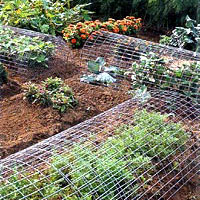Deer Deterrents That Work
Once roaming open fields and forests and controlled by natural predators, deer now must make their home near housing developments, office parks, and shopping malls, and their populations are growing. Little wonder then that they treat our gardens like buffet bars. Thoughtful plant choices, fences, dogs, and repellents help to keep deer at bay.
How To Do It

- As a first line of defense, line paths and garden borders with deer-repelling plants such as alliums and aromatic herbs like mints (Mentha), lavenders (Lavandula), sages (Salvia), and thyme (Thymus). If that first nibble smells or tastes nasty, the deer may just move on without venturing further into the garden.
- Woody plants like boxwood (Buxus), spireas (Spiraea), rhododendrons, and blue spruce (Picea pungens); annuals such as ageratum, celosias, cleomes, marigolds (Tagetes), and zinnias; and herbaceous perennials like coreopsis, lupines (Lupinus), and poppies (Papaver), touted by nurseries as "deer resistant," are just that. Do deer stay away from these plants? That depends on how hungry they are. They do seem to avoid many ornamental grasses and silver-leafed or fuzzy plants like artemisias, dusty miller (Senecio cineraria), and lamb's ears (Stachys byzantia).
- Avoid planting tulips, a deer favorite, use daffodils (Narcissus) instead. They are noxious to deer.
- Fence deer out: An eight-foot-high wire or plastic fence is effective but unsightly and expensive. Less aesthetically challenging, an electric fence with just a single strand of wire works perhaps 90 percent of the time. In the vegetable garden, arch two-by-four-inch-mesh wire fencing over vulnerable produce. The arches can be moved for working on the beds or harvesting.
- Even better than a fence is a dog, provided the dog is at liberty and willing to give chase to the deer.
- If you use scent and taste repellents, alternate them frequently.
- Stuff the toe of a cut-off panty hose leg with a handful of human hair and suspend it near a vulnerable plant.
- Hang bars of scented soap in trees and shrubs prone to deer browse.
- Apply a spray made by mixing water with crushed garlic, old eggs, and hot pepper sauce around vulnerable plants.
- Scatter Milorganite, a fertilizer made from sewer effluent, around ornamental plants that deer favor (not recommended for vegetable or herb gardens).
- Check with other gardeners in your area about their success with commercial products and regimes of alternating deer repellents before you purchase one or more products such as Living Fence, Hinder, Deer Off, Deer Away, or Bobbex.
Dog Versus Deer
Years ago I had a Bouvier and later a mutt, which were free to roam my farm during the day but were kept indoors at night. Whenever the dogs spotted deer, they gave chase. They never caught up with any, but their presence was enough to deter the deer from foraging in my yard at night, when they usually do most of their damage.
Invisible electronic dog fencing installed along the periphery of the property is a good way to keep a pet from straying. The dog wears an electronic collar that gives it a mild shock when it crosses a buried wire. After as short training session, the dog learns not to cross the buried electric fence.


